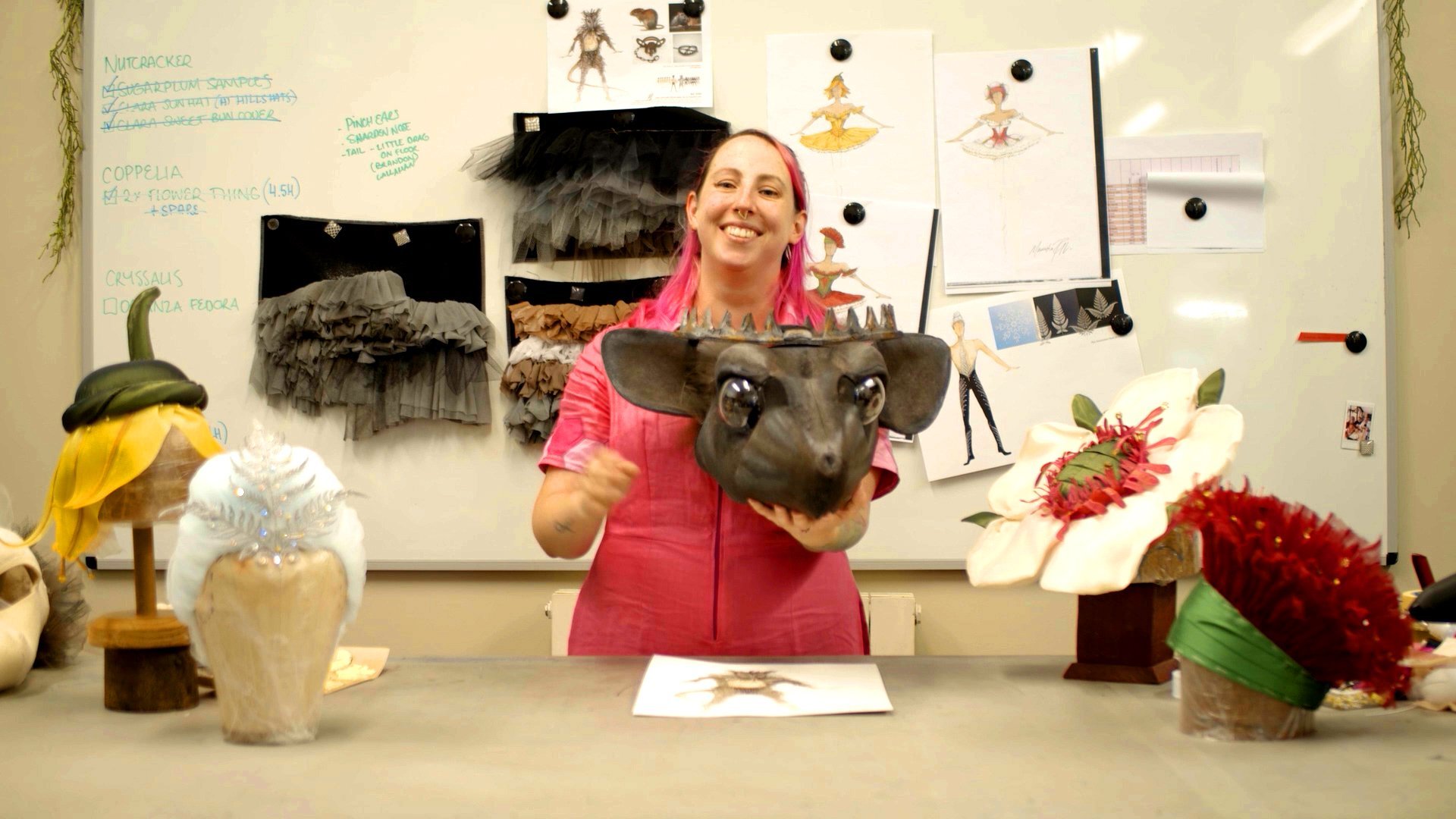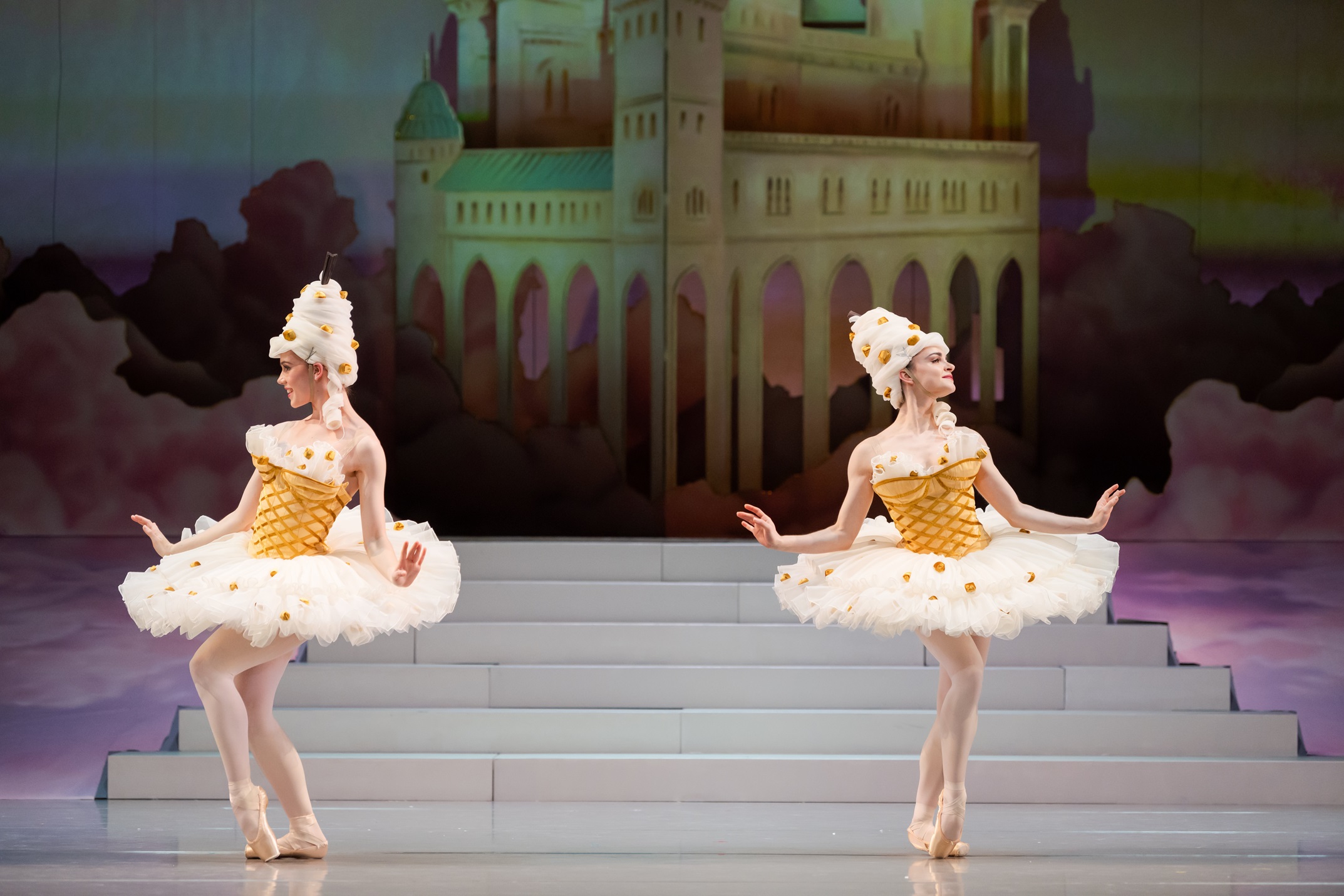
When dancers pull on one of Victoria Gridley’s hats or masks she wants them to feel comfortable, safe and confident in wearing it.
But she also needs to ensure the hats or masks help transform the dancers convincingly into their alter-egos, whether it is a rat king, possum, bird, flower or a pavlova fruit.
Her hats and masks, along with costumes, sets and props, help suspend the audience’s reality and draw them into the story as they follow the dancers’ movements across the stage.
So a lot is weighing on Gridley, a young costume artisan, who joined the Royal New Zealand Ballet (RNZB) team as an assistant cutter in 2017 and then stepped into the newly-vacant milliner and costume props position.
She got the job, she says, because she has the brain for weird shapes and forms.
"I’m really good at problem solving the weird."

Designing the sets and costumes was "lots and lots of fun", Grant Lord says.
"Your first audience is the people who are going to make it. They’re the ones that have to get inspired and get excited because they bring so much to the making of all these things. All the departments who built the set, the props, the costumes - everyone was really 100% committed."

"Her designs are always brilliant and if I always need clarification or a little bit more detail on some things, she’s always happy to whip that up or add another drawing or give me extra references," Gridley says.
"It’s nice to be able to push the boundaries a little bit."
Having worked on Romeo and Juliet, Hansel and Gretel, Sleeping Beauty, a traditional The Nutcracker and the ballet’s kids show Dazzelhands among others, Gridley has a few tricks up her sleeve to create her hats and masks.
"I sew, I glue, I rhinestone, I sew sequins, I do the embroidery machine, so I digitise, I paint. I go from start to finish with a lot of my pieces."

This version of The Nutcracker has required a lot of experimentation.
"That’s where I excel, is figuring things out. Things I haven’t done before, making it work for the dancers, making it comfortable and easily workable for Jessica [Taunt] on tour so that she doesn’t have to reset everything every night, or just make it as easy as possible for everybody else. So many different things you have to think about right through to that touring and packing.
"There was one show that we did that we had sequined hats, but the sequins were too loud, and they couldn’t hear the music from the orchestra. So we had to specifically make hidden ear-holes that were covered with mesh and then sew down all the sequins around that area so that they didn’t make sound as they danced."
The Nutcracker will be repeated again, so the hats and masks have to be long-lasting.
"It’s always in the back of my mind of how can I make things either easily replaceable if I know it’s going to die over time or make it so it lasts the distance."

Each piece required four to five days of research and development and then to construct took between one and five days depending on the piece’s complexity.
"So tūī and kererū definitely took a lot of hours for a single piece. They were probably about two weeks each. But then you’ve got other pieces like mānuka and kōwhai that ended up taking just eight hours to do one full one. But then you have to do that times six, so it adds up."
The biggest challenge, hat wise, was the kōwhai: it took several different variations until everyone was happy. She would put the design aside and move on to something else before returning to it after she had let some ideas "percolate".
"Trying to get the right likeness, and shape - but I think we got there really nicely. I really like them now."
Tūī and kererū required headpieces, incorporating a beak and eyes, and a "feathered" cloak. It took 30 feathered panels to create the kererū.
"It needs to be washable, but it needs to attach to the shoulders, but it needs to have flexibility, but the dancer needs to be able to hear things. So we need ear-holes. There was a lot in the birds that was a struggle to figure out and blend with the costume itself."

She also has to take into consideration whether more than one dancer will wear a hat, so it has to flexible to be worn by dancers with different sized heads and necks. The hats have to be secure to allow dancers to spin and jump.
"With boys’ hats, they don’t always have hair to pin it to, so how can we navigate things not slipping or falling off? Is there a tape that we can apply, to give a bit more grip on their head? Or is it all just the chin strap? Does the chin strap have to be multi-sized?"
One of the key scenes of The Nutcracker is the fight scene with the mice led by the rat king which in this version is made up of New Zealand’s introduced pests - rats, possums, stoats and weasels.
The rat king’s mask started out moulded in clay. Once happy with it Gridley enlarged the design on a printer to create a pattern. It required secret panels - so the dancers could see the floor and their feet as they moved - as well as being as light as possible.
"They all had to look different and imitate that specific rodent with the different shapes and the different colour and fur combinations. Each one has to function the same but look like the animal it’s meant to look like."
There are a couple of firsts with the rodents - lit-up eyes and the use of upholstery felt for the whole design. Felt was selected as it keeps sweat away from the battery, is fire retardant and keeps any heat away from the dancer.
"So if something was to go very badly, it’s not going to affect the dancer. It’ll just self-extinguish."
The glowing rodent eyes were created out of Christmas baubles and LED lights and required Gridley to learn how to solder.

She uses some obscure materials to make the designs come to life. Foam is used a lot as it is light. And they used hats to imitate wigs.
"So creating the snow hair is all out of tulle, which makes them about 70% lighter than a wig, so it’s not heavy to dance in. It can be hand-washed a lot easier than a wig and dried a lot faster than a wig. That was a fun thing that we tried out for the first time."
To keep all these tasks straight, Gridley starts out with a spreadsheet, the materials she needs to buy, the pieces she is responsible for and questions for Grant Lord.
Gridley has worked on the job part-time throughout the year, starting with two or three days a week and then becoming full-time close to the production opening. It took her nearly 1000 hours to create the hats and masks.
"Considering every single person wears something on their head, it’s pretty good, in my mind, being a team of mostly one."
King-Wall agrees.
"I have to give a shout out to her because, I think, coming into the costume department and seeing her work on some of those hats and masks, it really kept bringing it to life for me, especially in the early stages... it just kept giving me inspiration."
The work the whole team did to bring the new version to life over a year really shined through on the finished product which he sees as a homage to the history of The Nutcracker as well as also resonating with people who grew up with summer Christmases, he says.
"This is our Nutcracker - it’s because of the contributions that everyone’s made, it’s got a little piece of everyone in the company."
His favourite costume is the hokey-pokey dancers and his favourite character is the Storm Master, a new character created for the ballet’s snow scene and one he knew when choreographing it that he would have wanted to dance.
"It’s well beyond me these days, but I think I really enjoyed creating that one and I would have loved to have danced it."

Coming from Melbourne to study costume design at Toi Whakaari, Gridley has never returned home to live, instead enjoying the mix of work she gets to do in New Zealand. She is finding work starting to ramp up again after the Covid-related slump, seeing her calendar full for next year.
"Being able to afford my own studio and work out of that has also been really, really good. I’m happy that I can make that work. I love it. Out of all the jobs that I do, this (RNZB) is one of my absolute favourites."
To see:
The Nutcracker, The Regent Theatre, November 21-22











